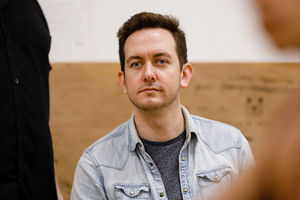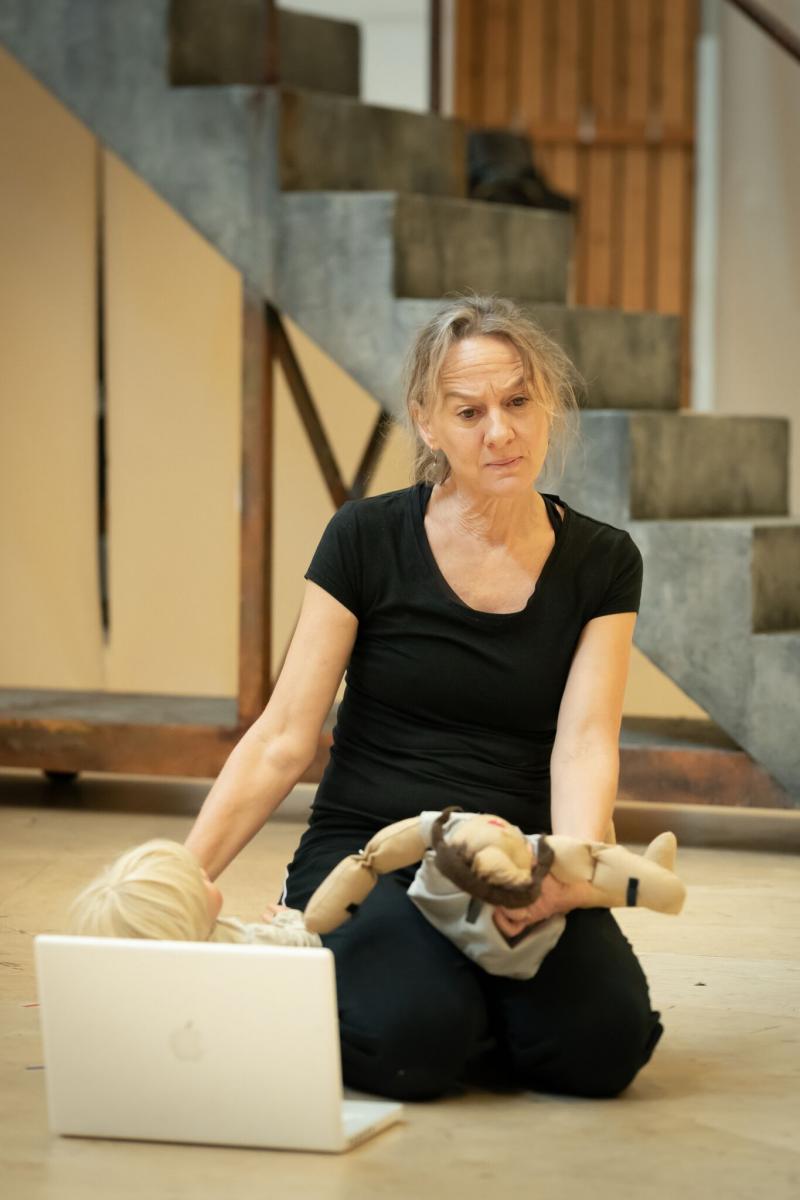Interview: Toby Olié Talks MY BRILLIANT FRIEND

My Brilliant Friend plays at the National Theatre this winter and is based on Elena Ferrante's celebrated novels. Condensing Ferrante's four Neapolitan Novels into two parts, the world is imagined on stage through Soutra Gilmour's design and Toby Olié's puppetry.
Taking us through bringing puppets and stories to life on stage, Toby shares how he got his start in the field and what the puppetry equivalent of playing Hamlet is!
What is your earliest memory of theatre, in any form?
There are a few theatre memories that have stuck in my mind to this day, I can distinctly remember a UV light underwater scene in a pantomime when I was around 6 - seeing fish swimming through mid air and an actor wrestle with the inflatable tentacles of an octopus had me spellbound.
I can also remember watching the 90's Children's Royal Variety performances on TV with my sister, they were always one long exciting narrative with all of the acts and celebrities worked into them. I loved the sets and was inspired into making miniature cardboard theatres out of shoeboxes for my toys to perform in.
What drew you into the world of puppetry?
I hold a number of things accountable for my somewhat niche career choice. I was addicted to Sesame Street and The Muppets films, and always enjoyed seeing puppets sharing a world with human characters.
Another defining step I can remember is making the entire 'Lonely Goat-Herd' sequence (after watching The Sound of Music with my grandparents) out of toilet rolls and cereal boxes, and performing the whole thing on their dining room table a few days later!
Growing up I then developed a taste for the practical special effects in movies like Jurassic Park and animations like The Nightmare Before Christmas, something about being transported and immersed in a universe so rooted in imagination but that felt so real has stayed with me and in my work to this day.
How did you get started? Formal training or on the job?
Thanks to my very supportive family and some incredibly encouraging teachers, I was always able to explore puppetry in my school work during art and drama lessons. To this day I consider puppetry the meeting point when art and acting collides.
I had initially looked into stage design courses for university, but when I discovered there was a puppetry BA course at the Royal Central School of Speech and Drama (now sadly discontinued) it was the only place I applied to - and thankfully got accepted.
I really enjoyed the mix of skills tuition and process of collaboration between different course strands, and it was whilst writing my final dissertation in 2006 that I got a call about an initial development workshop for War Horse at the National Theatre.
From this workshop I was consequently cast as one of the three puppeteers of Joey in the original production and stayed with it during its West End transfer before becoming an associate puppetry director of the show after finishing as a performer.
Being a part of such a unique production from its humble beginnings and participating in the epic process of collaboration between all its cast and creatives was a phenomenal induction into the world of theatre-making at such a big scale.

What have been some previous highlights for you, at the National and beyond?
Getting to play the role of Joey will be a hard puppeteer gig to beat, as essentially it's (as I joking call it) the puppetry equivalent of an actor getting to play Hamlet. You're on stage almost the entire show and go through the emotional and physical mill nightly, for 8 shows a week - it was exhausting but utterly exhilarating.
Alongside performing in War Horse I strived to continue making and directing puppets and was lucky enough to do so for a range of different shows, some of my favourites were: a 16 foot long, shape-shifting Cheshire Cat for the Royal Ballet's Alice's Adventures in Wonderland, getting to re-imagine Audrey II for Little Shop of Horrors at Manchester Royal Exchange and making my directorial debut (alongside fellow War Horse alumni Finn Caldwell) with The Elephantom at the National Theatre, which consequently led to the two of us founding our theatre company Gyre & Gimble to continue making shows together.
How does puppetry figure into the world of My Brilliant Friend?
This stage adaptation of My Brilliant Friend fluidly flows between the present and past of the friendship between its central characters Lenu and Lila. And Melly [Still] the director and April [De Angelis] the writer were keen that sometimes memories and fantasies would collide and blur as Lenu recounts her lifetime with Lila.
So puppetry is a very useful discipline to use to highlight some of these more challenging and extraordinary events, in fact the puppeteering of Lenu and Lila's childhood dolls in the opening scene is the action that leads the audience into the storytelling nature of the piece and sends the narrative back in time to when Lenu and Lila first meet playing with their dolls.
We then use puppetry to link the two daughters that Lila and Lenu have when they're older to their childhood dolls, and explore the idea of using a puppeteered version of Lila in a number of scenes when she experiences violence at the hands of her father and husband - allowing the audience to imbue the moment with their own interpretation of the character's trauma rather than the violence being somewhat fetishised by seeing it being done to an actress onstage.
How early were you brought into the process?
Having not been involved in the shows conception at the Rose Theatre in Kingston in 2017, this summer Melly asked me to come and develop the puppetry language they had initially devised for this new version at the NT.
We then undertook a short period of R&D at the National Theatre's amazing new work studio to explore their previous ideas and how they could be expanded and refined. One of the biggest breakthroughs of this time was the style and performance of Lenu and Lila's children in the part 2. Previously they had been puppets made of towelling, and my concern was that suddenly introducing puppets as 'real life' characters so far into the show would jolt the audience, when in the previous acts puppetry had always been used in moments fantasy or abstraction.
So I was keen to find a way that these poetic, cloth representations of their children could feel as grounded and dynamic as the actors around them - something that immediately took effect when we attached the cloth bodies of the puppet to the feet of their puppeteers, allowing the children to be a hybrid of puppet and the puppeteer's bodies and to run, stomp, jump and play like real toddlers.
How do you work with or train actors to interact with the puppets?
In shows like My Brilliant Friend where you have actors performing alongside puppets, the role of puppetry director involves not only working with the puppeteers in their operation and performance of the puppets but with the actors who relate to them on stage.
With puppeteers you work on them inhabiting the puppet with the basic principles of life - things like breath, eye line and weight - so that an audience can relate to them. Whereas an actor's interaction with a puppet, especially in this show, often involves them faking their own weight or muscular tension to help imbue the puppet with a strength or weight it doesn't have in reality.
It's a very delicate thing, and sometimes only the tiniest shift in their hands or their position next to/opposite the puppet can make or break its believability to the audience.

Catherine McCormack in rehearsals
What do you have to be conscious of when bringing puppets onto a stage?
Puppetry, like all theatre and acting, is at its best when it invites the audience in to complete the picture and narrative, so as a puppeteer you always have to have a more technical part of your performance fulfilling this ideal.
In My Brilliant Friend a number of the puppetry elements are a much smaller scale than the puppeteers operating them, so it is very easy for the puppeteer's bodies to compete with or overpower the puppet for the audience's attention. With the puppets of Lenu and Lila's children we've been doing a fair bit of work to keep the character's energy in the puppeteer's own feet and legs but not in their arms and torsos so there isn't a double image of puppets and puppeteer playing the character.
And in the more abstract moments of Lila's childhood trauma, it's imperative that the puppeteers neutralise the state of tension and muscularity in their own bodies so that the audience can focus on the puppet of Lila's and imagine that it has its own tension and muscularity.
What's something that may surprise people to learn about puppetry?
That even the shortest moments of action take a long time to rehearse!
Once you've unpicked the action to find the moments of breath and impulse the challenge is to keep them all feeling live and inhabited rather than choreographed. As even the most beautifully observed and delicately operated puppetry can feel hollow and demonstrative if the audience can't see the how and why of the character's actions and intentions.
It's an exciting challenge that is different for every project, and involves you devising a new set of conventions and etiquette for every puppet you work with.
My Brilliant Friend at the National Theatre until 22 February, 2020
Photo credit: Steve Tanner
Toby Olié: TobyOlie.com, @tobyolie
Comments

Videos

